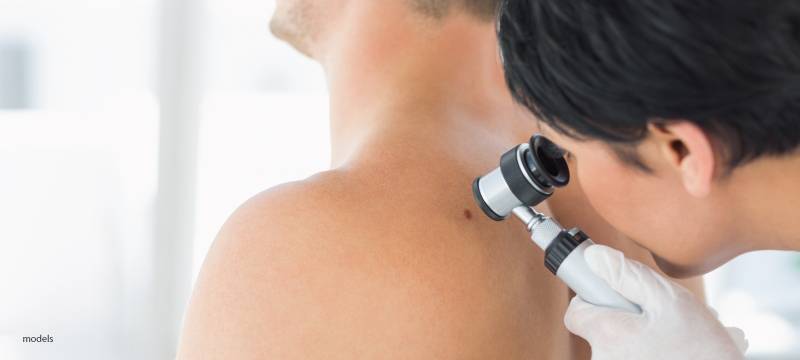Mole Removal Treatments: Know Your Options

Moles are common growths on the surface of the skin and most are completely harmless. Some moles, however, cause physical discomfort by rubbing on clothing, or psychological discomfort due to their location or appearance. If you have a mole that’s bothering you, safe removal by a doctor is quick and relatively painless.
Is My Mole Cancerous?
If your mole is changing in shape, size or color, or if it is painful, itchy, or bleeding, you should have a doctor look at it immediately to rule out skin cancer. Moles generally form in your youth, so any mole that appears after the age of 40 should also be seen by a doctor.
The common A, B, C, D, E method is used to flag moles that may be predictive of skin cancer.
- A – Asymmetry – your mole has an irregular shape or two sides that look different
- B – Borders – the edges of your mole are blurry or irregular
- C – Color – your mole has two different colors, or has recently changed color
- D – Diameter – your mole has recently grown, or is more than ¼ inch in diameter
- E – Evolving – your mole has changed in the last week or month
Not all atypical moles are cancerous, but they are more likely to become skin cancer. Self-check your moles regularly for changes. It can be helpful to regularly take pictures if you have a mole that is of concern.
Why Do Moles Develop?
A safe mole is normally black or brown in color, but can also be reddish or pink. Moles are raised clusters of skin cells that have grown tightly together. Moles generally appear within your first 25 years of life and may be clustered in groups or located singly. Moles develop due to genetics, sun exposure, or because of hormonal changes such as pregnancy.
Acquired moles are small moles that are round and even in color. These moles typically result from sun exposure, and appear early in life.
Atypical moles may be unevenly colored, or asymmetrically shaped. While these moles are not necessarily dangerous, people with a lot of atypical moles have higher rates of skin cancer and should take precautions to avoid overexposure to the sun.
Congenital moles are those you are born with and can vary markedly in size, color, and shape. Approximately 1 in 100 babies is born with a congenital mole.
What are my Mole Removal Options?
There are two common methods for mole removal depending upon the size or location of your mole. Both methods take place in your doctor’s office within a single visit.
Smaller moles can be removed with the surgical shave method. Your doctor will numb the area with a local anesthetic, then shave off the mole. While your skin will take time to heal, you won’t require stitches. Small moles may also be cauterized to prevent the mole from growing back.
Larger moles are routinely removed with the surgical excision method. Your doctor will numb the area, then cut out the entire mole, including some of the tissue behind it. Sutures will keep the area closed while it heals.
Even if your mole was harmless-looking, your doctor will likely send the removed tissue to be tested for cancer.
Does Mole Removal Hurt?
Your doctor will clean the area and then inject a local anesthetic prior to mole removal. You might feel the quick pinch of this needle, but you should feel no pain at all during the procedure.
Mole removal can take as little as a few minutes or as long as an hour, depending upon the size of your mole. If you need stitches, you should feel only mild discomfort, as the local anesthetic will still be working.
After the procedure, expect some mild discomfort or itching as the area heals.
What Should I Expect After Mole Removal?
After your mole removal, keep the area clean and follow your doctor’s instructions. The biggest risk with mole removal is infection.
Healing time will be anywhere from a few days to several weeks, depending upon the size of the mole that was removed. If you had stitches, they may be the type that dissolves on their own, or you’ll have them removed in a follow up appointment at approximately two weeks.
Stitches should be kept dry for at least 2-3 days after your mole removal. Avoid excessive sweating, long showers or strenuous exercise during this time. If you don’t have stitches, simply clean the area daily with mild soap and water, then apply an anti-bacterial cream.
Mole removal will leave a small scar where the mole once was. A skilled plastic surgeon will use very fine sutures and create a minimal incision, but scars cannot be completely avoided. To minimize scarring, avoid stretching the area while it heals, and be mindful of sun exposure.
If your mole was biopsied, your results should be available within 1-2 weeks.
Mole removal is quick and relatively painless. If you have a mole of concern for any reason, speak with your doctor about your options for mole removal, especially if you think your mole may be precancerous.

Want to know if it’s possible to remove “flat” moles on my cheek with laser perhaps?
Hi Leslie,
Thanks for reading our post and submitting a great question! It may be possible to address flat moles with lasers in some instances, however it depends on the exact characteristics of the mole. Your best bet would be to see a provider for an in-person consultation and discuss best treatment options.
We hope that helps!
Thanks,
WD Staff
Hi,
I have a mole on my face, its turning bigger and sometimes I feel pain.
I would like to know if you guys work with laser on Round Rock Clinic.
I would also like you to recommend a specialist so that I can make an appointment.
Thank you!
No problem Maria, we would love to help! I’ll have one of our patient coordinators contact you as soon as possible.
Hi. I’ve had a mole since childhood that has slowly gotten bigger. Is there a way to shrink the mole without completely removing it? I still love it but don’t want it to be as big or as raised.
Hi Leina,
Great question! First off, we would recommend having a dermatologist take a look especially given the change in size. With that out of the way, there are methods to reduce the size of a mole without completely removing it. Typically this is done through cryotherapy or electrolysis. Definitely consult with a board certified dermatologist to determine a treatment plan that will meet your needs.
We hope that helps!
Thanks,
WD Staff